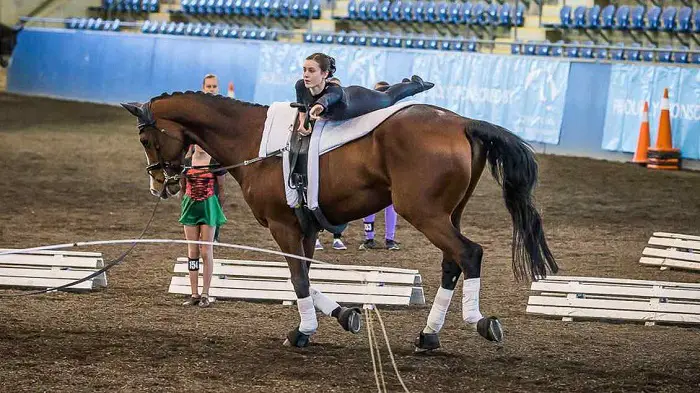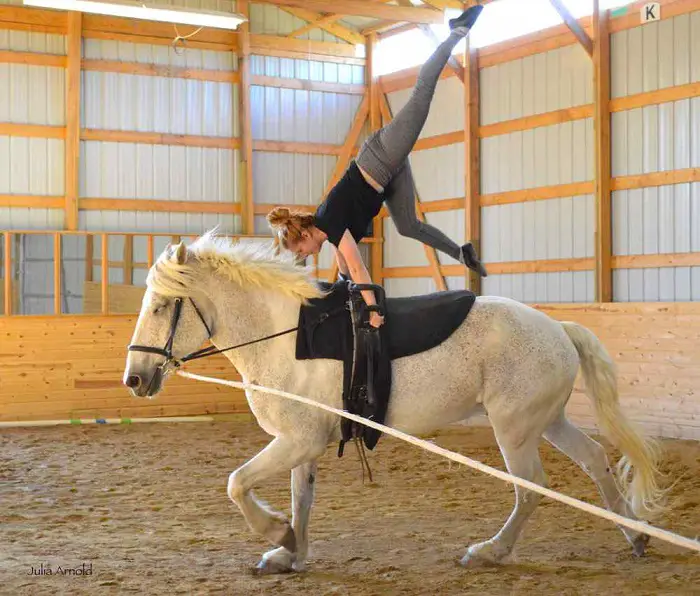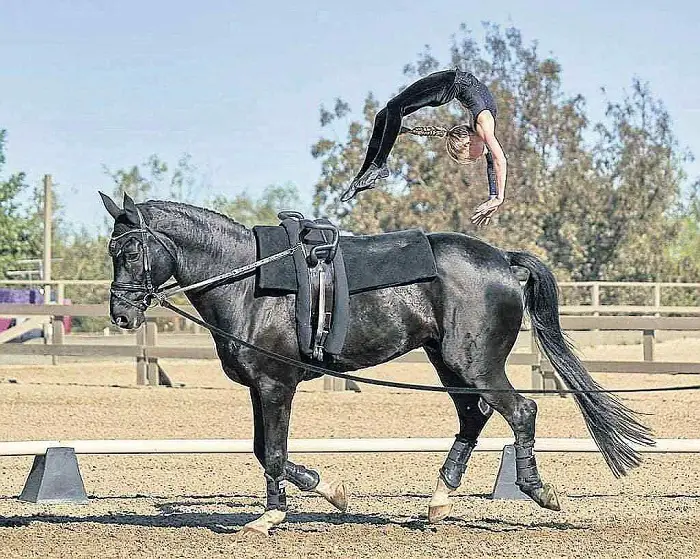Equestrian vaulting is a sport that involves performing gymnastic and dance-like movements on the back of a moving horse. It combines elements of both horsemanship and acrobatics, and it’s often described as a mix of gymnastics and dance on horseback. Equestrian vaulting can be performed individually or as part of a team, and it’s a popular sport in many countries, particularly in Europe and North America.
Critical Aspects of Equestrian Vaulting
Here are some critical aspects of equestrian vaulting:
- Horse: Equestrian vaulting is typically performed on a horse specially trained for this sport. The horse is equipped with a surcingle, a special padded harness with handles for vaulters to hold onto.
- Vaulters: The athletes who perform the vaulting exercises are known as vaulters. They perform a series of choreographed movements, including various gymnastic elements, such as flips, handstands, and balances, while on the back of the moving horse.
- Routine: Vaulters perform routines set to music, ranging from simple exercises to complex and artistic performances. These routines are judged based on technical execution, artistic presentation, and difficulty of the movements.
- Team and Individual: Equestrian vaulting can be done individually or as a team. Team routines often involve multiple vaulters working together on the same horse, while individual routines showcase the skills of a single vaulter.
- Safety: Safety is a paramount concern in equestrian vaulting. The horse is usually guided by a longeur, who leads the horse in a circle on a long line. The longeur ensures that the horse maintains a consistent speed and direction, allowing the vaulters to focus on their routines.
- Competition: Equestrian vaulting is a competitive sport, and national and international competitions are held regularly. These competitions feature various categories, including individual male and female, pas de deux (a pair of vaulters), and team events.
- Accessibility: Equestrian vaulting is often considered an accessible way to introduce people to equestrian sports. It allows individuals to develop balance, coordination, and strength while building a connection with horses.
History of Equestrian Vaulting
The history of equestrian vaulting dates back centuries. It has evolved from its origins as a form of training for mounted warriors to become a modern competitive sport and artistic discipline. Here’s an overview of the history of equestrian vaulting:
- Ancient Origins: Equestrian vaulting has its roots in ancient civilizations, particularly in Greece and Rome. In these societies, it was typical for soldiers and warriors to practice vaulting on horseback to improve their riding skills and increase their agility in battle.
- Medieval and Renaissance Periods: During the Middle Ages and the Renaissance, equestrian vaulting continued to be practiced, often as part of the training for knights and cavalrymen. Vaulting skills were seen as essential for mounted combat and incorporated into the education of nobility.
- Circus and Entertainment: In the 18th and 19th centuries, equestrian vaulting became popular in circuses and traveling shows. Performers would showcase their acrobatic skills on the back of galloping horses, often dazzling audiences with daring feats.
- Modernization and Standardization: Equestrian vaulting began taking a more standardized form in the late 19th and early 20th centuries. Rules and regulations were established, and the sport started to resemble its modern form, with specific exercises and routines performed on horseback.
- Olympic Consideration: Equestrian vaulting has never been included as an Olympic sport but has been considered for inclusion several times. While it has yet to achieve Olympic status, it is recognized by international equestrian organizations and has a solid following in various countries.
- Development of National and International Organizations: National and international vaulting organizations have been established to promote and regulate the sport. The International Equestrian Federation (FEI) is the governing body for equestrian sports, including vaulting, at the international level.
- Competitive Sport and Artistic Expression: Equestrian vaulting has become a competitive and artistic discipline. It is practiced at various levels, from local and regional competitions to world championships. Vaulters often create choreographed routines that showcase their gymnastic and artistic abilities.
- Inclusivity: One of the notable aspects of equestrian vaulting is its inclusivity. It provides opportunities for people of various ages and abilities to participate in equestrian activities and develop physical skills while working with horses.
Types of Equestrian Vaulting
Equestrian vaulting encompasses various types and categories, each with unique characteristics and rules. Here are some of the main types of equestrian vaulting:
- Individual Vaulting: In this category, a single vaulter performs a routine on the back of a moving horse. The routines are typically set to music and include a combination of gymnastic movements, dance, and balance.
- Pas de Deux: Pas de deux, which means “dance for two” in French, involves a pair of vaulters performing together on the same horse. This category emphasizes synchronization between the two vaulters and often includes intricate partner moves and choreography.
- Team Vaulting: Team vaulting involves a team of vaulters (usually three to six) performing together on the same horse. Team routines are highly coordinated and complex, with vaulters working together to create visually appealing and technically challenging performances.
- Freestyle Vaulting: Freestyle vaulting allows vaulters to create their routines, typically set to music of their choice. This category provides vaulters with the opportunity to showcase their creativity and individuality.
- Barrel Vaulting: Barrel vaulting is a variation of equestrian vaulting in which vaulters perform their routines on a stationary barrel or barrel-like apparatus instead of a moving horse. It is often used for training or when a horse is unavailable.
- Children’s Vaulting: Some competitions have specific categories for children or youth vaulters, allowing young athletes to participate in the sport at their level of skill and experience. These categories often have age-appropriate routines and exercises.
- Therapeutic Vaulting: Equestrian vaulting can also be adapted for therapeutic purposes, often referred to as therapeutic or adaptive vaulting. It is a form of physical therapy and recreation for individuals with disabilities, helping them improve balance, coordination, and confidence.
- Recreational Vaulting: Not all vaulting activities are competitive. Many equestrian centers offer recreational vaulting programs that allow individuals to learn vaulting skills and enjoy the experience without the pressure of competition.
Equestrian Vaulting Competition
Equestrian vaulting competitions are events where vaulters showcase their skills and perform routines on the back of a horse or a stationary barrel, depending on the specific category. These competitions provide a platform for vaulters to demonstrate their technical abilities, artistry, and teamwork. Here’s an overview of what you can expect from equestrian vaulting competitions:
- Categories: Equestrian vaulting competitions feature various categories, including individual, pas de deux (pairs), team, freestyle, and sometimes children’s or youth divisions. Each category has its own rules and requirements.
- Routines: Vaulters perform choreographed routines set to music. These routines are carefully designed and can include a combination of gymnastic movements, dance elements, balances, and creative transitions.
- Scoring: Competitions are typically judged based on several criteria, including technical execution, artistic presentation, the difficulty of movements, and overall performance. Judges assess factors such as form, timing, harmony with the horse (or barrel), and adherence to the choreography.
- Judging Panels: A panel of judges, often consisting of multiple individuals with expertise in equestrian vaulting, assesses each vaulter’s performance. Scores are awarded for each element of the routine; the final score is the sum of these individual scores.
- Equipment: Vaulters wear special attire, including tight-fitting leotards and often matching costumes that complement the theme of their routine. Safety equipment such as helmets is also required for the vaulters. The horse may have a surcingle and side reins to assist with control and stability.
- Teamwork: In team and pas de deux events, teamwork and synchronization are essential. Vaulters must coordinate their movements with one another and with the horse to create a harmonious and visually appealing performance.
- Freestyle Routines: In freestyle vaulting, vaulters can design their routines, allowing for artistic expression and individuality. Freestyle routines often feature innovative choreography and unique movements.
- Children’s and Youth Competitions: Competitions for children and youth vaulters are designed to be age-appropriate and often feature less complex routines. These competitions allow young athletes to gain experience and confidence in the sport.
- International and National Levels: Equestrian vaulting competitions occur at various levels, including local, regional, national, and international levels. Elite vaulters may compete in world championships and other prestigious events.
- Inclusivity: Equestrian vaulting competitions may also include adaptive or therapeutic vaulting categories, allowing individuals with disabilities to participate and showcase their abilities.
Horse Vaulting Movements
Equestrian vaulting movements involve a wide range of gymnastic and dance-like exercises on the back of a moving horse or a stationary barrel. These movements require balance, strength, coordination, and skill. Here are some joint horse vaulting movements:
- Mount/Dismount: The vaulter begins and ends the routine by mounting and dismounting the horse. This can involve various techniques, such as a forward or backward somersault onto the horse’s back or a controlled slide off the horse’s side.
- Basic Seat: The vaulter sits in a primary riding position on the horse’s back, often with one or both legs extended to the side. This position serves as a foundation for many other movements.
- Flag: The vaulter stands on the horse’s back with one leg extended horizontally while balancing on the other leg. This creates a flag-like position, and the vaulter may perform various arm movements for artistic effect.
- Scissors: In this movement, the vaulter straddles the horse’s back with one leg to the front and the other to the back. The legs are extended and often open and close rhythmically.
- Mill: The vaulter stands with one foot on the horse’s back and the other foot extended to the side. The extended leg rotates around the horse’s back while the vaulter maintains balance.
- Handstands: Vaulters perform handstands on the horse’s back, with legs extended vertically or in a split position. Handstands require considerable upper-body strength and balance.
- Kneeling: Vaulters may kneel on the horse’s back, often with one knee down and the other leg extended to the side or behind them. This position can be used as a transition between other movements.
- Flank: In the flank position, the vaulter lies horizontally on the horse’s back with legs extended to the sides. The arms are often used for balance and support.
- Shoulder Stand: In this movement, the vaulter balances on their shoulders while standing on the horse’s back. This can be done with one or both legs extended vertically.
- Backbend: The vaulter arches backward, often with one or both hands touching the horse’s back, while maintaining balance. This movement requires flexibility and core strength.
- Tandem: In a tandem movement, two vaulters perform synchronized exercises on the horse’s back. This can involve various positions and transitions, showcasing teamwork and coordination.
- Freestyle Movements: Freestyle routines allow vaulters to incorporate creative and unique movements into their performances. These can include spins, jumps, twists, and other dynamic elements.
Rules and Regulations of Horse Vaulting
Like any sport, horse vaulting has specific rules and regulations that govern how it is practiced and competed. These rules ensure safety, fairness, and consistency in the sport. The rules of horse vaulting can vary slightly depending on the governing body and the level of competition, but here are some standard rules and guidelines:
- Safety: Safety is a top priority in horse vaulting. Vaulters are required to wear appropriate safety gear, including helmets, gloves, and appropriate footwear. The horse should be well-trained and in good health. A longeur (the person leading the horse) is typically present to guide the horse and ensure safety.
- Horse Suitability: The horse used in vaulting must be suitable for the sport. This includes having a calm and steady temperament, an even gait, and maintaining consistent speed and direction. Horses are often chosen based on their suitability for vaulting.
- Longeur: A longeur leads the horse in a controlled circle during the vaulter’s routine. They must have experience and expertise in longeing horses and ensuring the safety of both the vaulter and the horse.
- Scoring: Scoring in horse vaulting is typically based on technical execution, artistic presentation, and difficulty of movements. Judges assess each vaulter’s performance and assign scores for various routine elements. The final score is calculated based on these individual scores.
- Dismounting and Mounting: Vaulters are required to mount and dismount the horse safely and under control. Dismounts often involve specific techniques to ensure the vaulter lands safely on the ground.
- Illegal Movements: Some specific movements and techniques are considered illegal or unsafe in horse vaulting. These may include certain dismounts, excessive use of the longeur’s assistance, and any actions that put the vaulter or the horse at risk.
- Time Limits: Routines are typically performed within specified time limits, and vaulters must adhere to these time constraints. Going over the allotted time can result in point deductions.
- Age and Eligibility: Competitors are often categorized by age and experience level. Youth and junior categories exist for younger vaulters, while senior categories are for more experienced athletes. Some competitions may also have novice or beginner levels.
- Protests and Appeals: There are procedures for handling protests or appeals if there are disputes over scores, rule violations, or other issues during a competition.
- Freestyle Creativity: In freestyle vaulting, vaulters can design their routines creatively. However, routines must still adhere to safety guidelines and may be subject to approval by competition organizers.
- Code of Conduct: Vaulters are expected to adhere to a code of conduct that promotes sportsmanship, respect for others, and ethical behavior in training and competition.
Non-competitive Equestrian Vaulting
Equestrian vaulting isn’t solely about competitive sports. It can also be enjoyed as a recreational activity, therapeutic practice, or artistic expression. Non-competitive equestrian vaulting offers a range of opportunities for individuals of all ages and abilities to engage with horses, improve physical fitness, and build skills in a non-competitive and enjoyable environment. Here are some aspects of non-competitive equestrian vaulting:
- Recreational Vaulting: Many equestrian centers offer recreational vaulting programs that allow individuals to learn vaulting skills and have fun without competition. These programs often include lessons, group activities, and the opportunity to perform basic vaulting exercises.
- Therapeutic Vaulting: Equestrian vaulting, known as therapeutic or adaptive vaulting, can be adapted for therapeutic purposes. It is a form of physical therapy and recreation for individuals with disabilities. Vaulting exercises help improve balance, coordination, and core strength while building confidence and a sense of accomplishment.
- Skill Development: Non-competitive vaulting is an excellent way for beginners to learn the fundamentals of vaulting. Participants can gradually progress from basic exercises to more advanced movements as they build strength and confidence.
- Team Building: Vaulting often involves working in teams or pairs, even in non-competitive settings. This fosters participants’ cooperation, communication, and teamwork, promoting social interaction and relationship building.
- Fitness and Conditioning: Vaulting provides a full-body workout, helping participants develop strength, flexibility, and balance. It is an excellent way to stay physically active while enjoying time with horses.
- Artistic Expression: Non-competitive vaulters can explore the artistic side of the sport by creating routines and performances that showcase their creativity and individuality. This can be a rewarding form of self-expression.
- Horse Connection: Vaulting allows participants to develop a strong bond with horses. The trust and rapport between vaulters and their equine partners can be deeply fulfilling.
- Community and Inclusivity: Non-competitive vaulting programs often foster community and inclusivity. They welcome participants of all ages, backgrounds, and abilities, promoting a supportive and welcoming atmosphere.
- Fun and Enjoyment: Ultimately, non-competitive equestrian vaulting is about having fun and enjoying time with horses and fellow enthusiasts. It can be a fulfilling and rewarding activity for those who love horses and want to explore their potential in a supportive, relaxed environment.
Final Talk on Horse Vaulting
Horse vaulting is a captivating equestrian discipline that blends athleticism, artistry, and horsemanship. It’s a sport with a rich history, evolving from its origins as a form of training for mounted warriors to become a modern expression of physical prowess, creativity, and teamwork.
In horse vaulting, athletes, known as vaulters, perform a variety of intricate and dynamic movements on the back of a moving horse or a stationary barrel. These movements encompass gymnastics, dance, balance, and strength, executed with precision and grace. Vaulters often create routines set to music, and the performances can be breathtaking, showcasing the remarkable bond between humans and horses.


